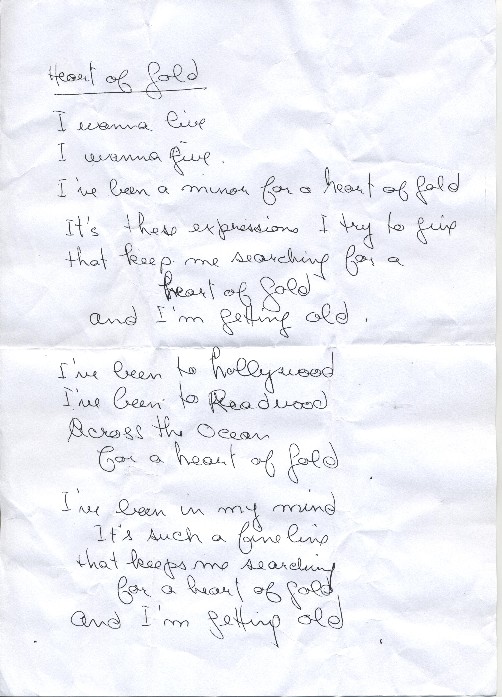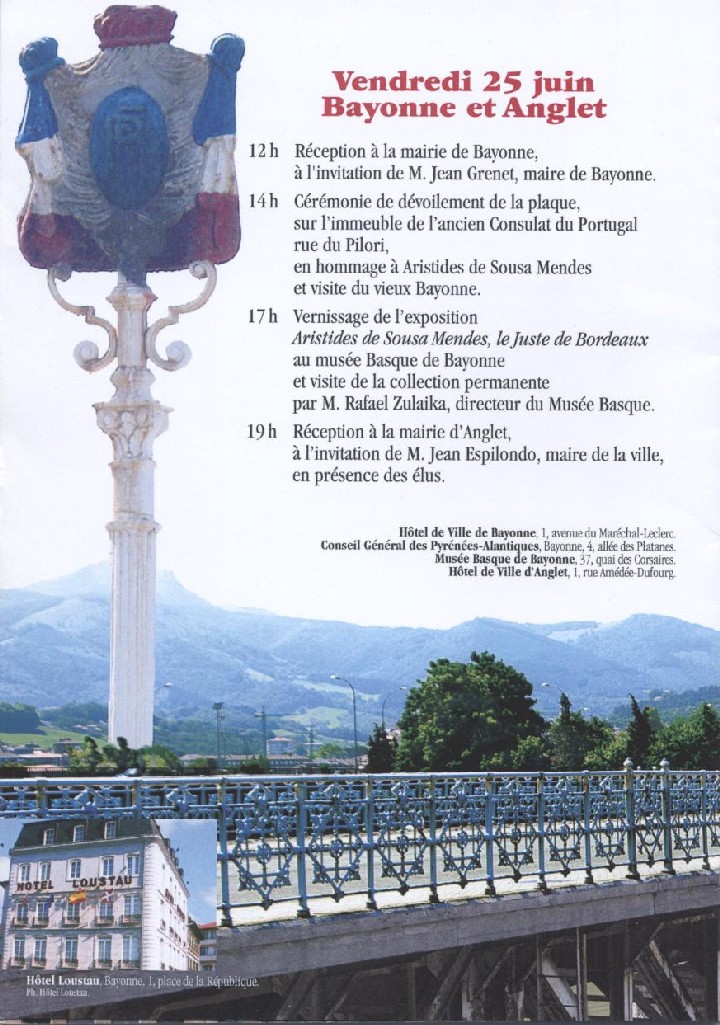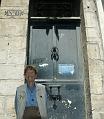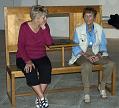We assemble early in the morning at the hotel lobby, and local volunteers shuttle us to the train station. José Da Silva, a member of le Comité who was very kind to me during the dedication of the monument to Aristides de Sousa Mendes yesterday, is our chauffeur. We board the train to Bayonne at 7:15AM. Our young friend, Kevin Gironnay, is returning to Paris today, but he gets on the train to bid everyone farewell. Kevin has been a most welcome addition to the group, and we all wish him good luck with his radio project. |
|
En route, I get to talk a little more with Georges Bouhana, vice president of le Comité national français en hommage à Aristides de Sousa Mendes and president of LICRA Aquitaine. We have a look at my photos of Jacques, Kate and Arthur during the summer of 1939 in Cabourg (a beach resort in Brittany) and from Estoril in 1940. It was from Cabourg that the family began the process of emigration by relocating to Bordeaux. Marc and Gisèle also enjoy looking at my photos and documents, and I enjoy their warmth. We also look at some of Jerry Jarvik’s photos from the last few days on his laptop, and I transfer my photos to Hellen’s portable hard drive. |
|
Arriving in Bayonne around 10AM, we deposit our luggage at the Hotel Loustau and, upon my suggestion, take coffee at a nearby café. I cause a minor commotion by paying for everyone's coffee. Soon we are joined by Hellen’s wonderful cousin Véronique, and Jacqueline Cancel, a member of le Comité and coordinator of our excursions in Bayonne, Anglet and Hendaye. Véronique leads us across the bridge to a great outdoor flea market beside the river Nive in the center of town. There are a lot of antique postcards and books, and a very nice indoor food market with cafés on each corner. We browse the wares, enjoy some fresh strawberries, and soak up a little of the ambiance of this charming and picturesque town. Bayonne is very near the Spanish frontier (border) and the northern-most city of the Basque region. It is also a centre of Jewish culture dating back to the 16th century. Bayonne is also famous for chocolate, which was introduced to the town by Jews coming up from Portugal. |
|
We attended a reception at the Hôtel de Ville at the invitation of the mayor of Bayonne, M. Jean Grenet. Paul Abranches spoke on behalf of the delegation. One question he is always asked, he said, is ‘so what happened to the family?’ (after the consul was removed from his post by Salazar in 1941). Thankfully, he said, things are better now, but it was not always thus. His father, Jean-Paul, worked hard for many years to set the record straight and transmit the true story of Aristides de Sousa Mendes to the world at large... It was a difficult and frustrating struggle, and at times he truly despaired, even as his wife urged him to continue to petition the Portuguese government. Reflecting upon this, I was again deeply moved and yet again I wept freely, and could not resist the urge to embrace Paul after his speech. Ana Margarida said to me, “I don’t like seeing you so sad,” but I assured her that I was not simply sad, but overcome with many different emotions, and the cathartic release of crying was actually pleasurable on a deeper level. |
|
We then walked to the site of the old consular offices in Bayonne, where Aristides de Sousa Mendes relieved the acting consul and began again to issue visas to the refugees waiting here by the Spanish border. The consular apartments were on the Rue du Pilori, on the hillside leading up to the great cathedral. Sousa Mendes had set a table up on the street so that the refugees would not have to climb the treacherous staircase to receive their visas. It was here that Lissy Jarvik’s father came from Biarritz to receive visas for his family, in late June of 1940. This was truly the last chance for the Jarvik family, as Aristides de Sousa Mendes would soon after be confronted by the Salazar government and recalled to Lisbon. |
|
We were next received at the magnificent Musée Basque on the banks of the river Nive. The moment I stepped into the reception salon I was approached by Véronique Fourcade of the regional newspaper Sud-Ouest. I explained to her I had learned about Aristides de Sousa Mendes just a few weeks earlier, when Hellen Kaufmann contacted me about coming on this voyage. We revisited the conversation I had yesterday with Patricia, this notion that the descendants of Aristides de Sousa Mendes and the sauvées constitute one big family, and how I had come to feel 'historically descended' from him myself. |
|
We were welcomed to the Basque Museum by director Rafael Zulaika and a very beautiful Basque woman (whose name I did not record, but I believe it to be Maïté Péchereau?) who was articulate in many languages including English, French, Spanish, and of course Basque. She gave us a great overview of Basque people, history and culture, and conducted us on a guided tour of the museum. |
|
On the upper floor we viewed exhibitions of Basque architecture, including a full reconstruction of the interior of a traditional Basque home. The furnishings were wonderful -- my favorite piece was a special bench with a table between two seats. This bench is traditionally placed perpendicular beside the fireplace, and was the place where the patriarch and matriarch of the family would sit. Bayonne was an important trade center, located on the river Nive which flows directly into the Atlantic. The Basque were adept ship-builders, and the museum is housed in a former shipping warehouse. There was a very ancient looking hand made hull, and other nautical exhibits. Although quite fatigued, I was reinvigorated by the fantastic wooden sculptures of Basque artist Nestor Basterretxea on the lower floor. |
|
On a circular hall overlooking a central atrium, Manuel Diaz made a presentation in front of the new exposition ‘Aristides de Sousa Mendes, le Juste de Bordeaux.’ The exhibit consisted of roughly 14 large panels, covering his early career, the arrival of the refugees in Bordeaux, wrestling with his conscience, taking action in Bordeaux, Bayonne, Anglet and Hendaye, his terrible fate (he was stripped of his honor, income, even any possibility of travel outside the country by the cruel reprimands of Salazar), and the rehabilitation of his memory and legacy by family members and historians, beginning in the 1980s. Manuel's presentation was the most relaxed and casual yet, and I will always remember the only time I saw him laugh. |
|
After this presentation I was invited to make a speech in the atrium myself, interpreted in French by our tour guide. It is impossible to describe the feeling of sharing my story in public in this way, honoring the memory of my grandparents Jacques and Kate, and my late father Arthur Oesterreicher. I was able also to convey my own very recent discovery of this history, after many years of wondering about Arthur’s childhood, preserving his records and documents along with those of my grandparents, and the great joy of being welcomed and embraced by the Sousa Mendes family and members of the committee. |
|
| Marc d’Août (another grandson of Aristides) and his lovely wife Gisèle expressed great affection and gentle appreciation, and regret that we could not easily communicate more deeply (neither of them speak English). Of course they have seen the tears in my eyes each day just as I have seen the love and admiration in theirs. I can tell you that the nobility, compassion and humanity of Aristides de Sousa Mendes is still extant and evident in his descendants and their families. | |
The delegation retired to a private salon in the Basque Museum and sat in a great circle as Lissy Jarvik told much of her life’s story – from childhood experiences in Holland and Berlin, the harrowing emigration she endured, along with her sister and parents, via Amsterdam, Paris, Biarritz, and Figueira de Foz, on through her early life in New York. I cried again and again as we listened to her many poignant anecdotes, and the uplifting story of her career and family. Truly a pillar of strength and determination, she stood up for herself working in the shipping industry, worked hard to pay for her education, earning her PhD, and finishing medical school at a time when very few women and very few Jews were able to do so. |
|
We returned to the Hotel Loustau where I exchanged rooms with Michael and Michael Fink (another charming thing about this lovely couple is that they are *both* named Michael) in order to make them more comfortable. The three of us have shared a lot of great personal stories, literary recommendations, and friendly debates over this week, and have developed a great mutual appreciation. Mr. Michael is a professor of Yiddish literature at Rhode Island School of Design, and he has worked with and known some very great artists, including Isaac Bashevis Singer and David Byrne of the Talking Heads. He tells truly wonderful stories with great sensitivity and wit. I look forward to corresponding with them both over the years to come, and hope to visit them in Rhode Island someday soon. |
|
| I had an opportunity during this pause at the hotel to write a note in the ‘memory book’ -- Manuel Diaz has presented it to be signed by every dignitary who has received us, and in which all of the members of the delegation will also have a chance to write their thoughts. This will be a very interesting memento and record of the voyage. We also had lovely cards for the delegates to sign as gifts for Hellen Kaufmann and Manuel Diaz, in appreciation of their work to transmit the story of Aristides de Sousa Mendes and for coordinating this remarkable journey for all of us. | |
We took a a short bus ride to the neighboring town of Anglet, where we were received in the early evening by the kindly mayor Jean Espilondo. He welcomed us in front of a very large triptych of stark images from the extermination camps of the Holocaust, commissioned or donated by a local artist the last time the Sousa Mendes family visited Anglet. It was Jerry Jarvik’s turn to speak on behalf of the delegation, and he expressed what an emotional voyage of discovery we have shared over the course of these five days together, the profound feeling of knowing that your very existence, and that of your entire family, depends upon the act of one righteous and hugely compassionate person, and the sense of membership in the extended honorary family of Aristides de Sousa Mendes. His tearful speech paid a fitting tribute to the memory of Aristides and Angelina, and also the victims and survivors of the Shoah. I know he felt the waves of love washing over him that I too felt this afternoon from all assembled. We were refreshed by a delicious and delicately sweet white wine of the Basque country, and I told Gérald Mendes and Paul Abranches I was certain their grandfather would have been proud of their efforts to perpetuate his legacy and the voyage we have shared this week. |
|
Gérald confessed that he had come up with a surprise for me, but needed my assistance to realize his idea. Gérald wanted the group to sing the song ‘Heart of Gold’ by Neil Young to me ‘a capella’ but he had trouble remembering the lyrics and could not print them out at the hotel. The mayor generously logged into a computer at the reception desk so we could access the internet, but his profile was not set up to print from that workstation, so Gérald handwrote the words and we borrowed a photocopier to make some copies. |
 |
Manuel drove Lissy and Jerry to Biarritz so she could visit the place where her family anxiously awaited her father as he went to Bayonne to get visas from Aristides, while the rest of returned by bus to Bayonne. They rejoined us for a wonderful dinner at La Grange restaurant along the banks of the Nive in the ancient Jewish quarter of the town. Gifts were presented to Lissy, Hellen and Manuel, and we all received membership cards in le Comité national français en hommage à Aristides de Sousa Mendes. Hellen’s fiancé Gerard also joined us, and I was again reinvigorated by the atmosphere of camaraderie and bonhomie, and of course fabulous food and wine. |
|
Over dinner the music of Leonard Cohen came up, an artist I grew up with and whom Arthur described as “his fiercest rival Jewish poet.” Mrs. Michael Fink sang ‘Suzanne’ at the table, after which I sang the song ‘Hey, That’s No Way to Say Goodbye.’ Hellen sang a little bit (the French parts) of ‘The Partisan’ with me, a song a little bit too somber for the occasion but so very fitting as well. It is really heartwarming to know that I am the first ‘sauvée’ Hellen has found (she said, "and you'll always be the first") knowing that she really wants to find us all. Could you imagine a stadium full of people who owe their life to Aristides de Sousa Mendes? A stadium would not be nearly big enough – now try to imagine that! |
|
A handful of us stopped on a corner by the bridge leading back, and yes, we sang ‘Heart of Gold’ a capella on the streets of Bayonne. I also sang Neil Young’s ‘Old Man’ to Gerald and I think I planted an earworm in him… I heard him softly singing “…24 and there’s so much more” as we strolled through the town under the burgeoning moon. It was a lovely evening, and tired as I was, I enjoyed staying out that last hour with Ana Margarida, Gerald, Louis Philippe, and Paul: my newfound ‘cousins’ in the vast extended family (its uncounted members yet to be discovered) of Aristides de Sousa Mendes. |











